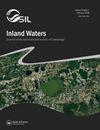模拟一个大型温带浅湖中自下而上和自上而下的过程如何控制生物群的主要功能群
IF 2.3
3区 环境科学与生态学
Q1 LIMNOLOGY
引用次数: 2
摘要
衡量营养水平之间定量相互作用影响的生态系统模型是生态系统研究和渔业管理中广泛使用的工具。我们使用Ecopath with Ecosim (EwE)建模套件为爱沙尼亚Võrtsjärv的大型浅湖构建了一个质量平衡营养模型。该模型经过36年(1983-2018)的校准,包括23个官能团。我们研究了营养关系、功能群相互作用、能量通量和相对于生物量对生态系统有高影响的关键群。我们基于浮游植物、浮游动物、大型底栖动物、食鱼鱼类和鲷鱼等主要功能类群未来20年的生物量变化,测试了6种假设情景。预测情景的结果表明,浮游生物群落生物量的变化会影响整个食物网。在消费者中,大型底栖动物对食物网平衡至关重要,因为它们的生物量减少也会减少鱼类群落的生物量。渔获量的变化对其他种群的生物量差异影响很小。虽然对大型鱼食性动物的捕捞压力增加会对食物网的其他部分产生显著影响,但像鲷鱼这样的非鱼食性鱼类的减少几乎没有影响。结果表明,小型浮游植物的生物量与鱼类之间存在正相关关系,暗示自下而上的营养过程普遍存在。这些结果有助于评估浅湖的营养动态,并对渔业和生态系统管理具有重要意义。本文章由计算机程序翻译,如有差异,请以英文原文为准。
Modelling how bottom-up and top-down processes control the major functional groups of biota in a large temperate shallow lake
ABSTRACT Ecosystem models that measure the impact of quantitative interactions between trophic levels are widely used tools in ecosystem studies and fishery management. We constructed a mass-balance trophic model using an Ecopath with Ecosim (EwE) modelling suite for large shallow Lake Võrtsjärv, Estonia. The model was calibrated for 36 years (1983–2018) and included 23 functional groups. We examined trophic relationships, functional group interactions, energy fluxes, and keystone groups having a high impact on the ecosystem relative to their biomass. We tested 6 hypothetical scenarios based on future biomass changes for the major functional groups (phytoplankton, zooplankton, macrozoobenthos, piscivorous fish, and bream) for 20 years. The output of the predictive scenarios showed that the biomass changes of planktonic groups would affect the whole food web. Among consumers, macrozoobenthos was crucial for the food web balance because a reduction of their biomass would also reduce the biomass of the fish community. Changes in fish catches would cause minimal biomass difference in other groups. While increased fishing pressure on large piscivores would have a marked effect on the rest of the food web, the reduction of nonpiscivorous fish like bream would have little effect. The results suggested a positive relationship between the biomass of small phytoplankton and fish, alluding to the prevalence of bottom-up trophic processes. These outcomes could be helpful for assessing trophic dynamics in shallow lakes and important aspects for fisheries and ecosystem management.
求助全文
通过发布文献求助,成功后即可免费获取论文全文。
去求助
来源期刊

Inland Waters
LIMNOLOGY-MARINE & FRESHWATER BIOLOGY
CiteScore
6.10
自引率
9.70%
发文量
34
审稿时长
>12 weeks
期刊介绍:
Inland Waters is the peer-reviewed, scholarly outlet for original papers that advance science within the framework of the International Society of Limnology (SIL). The journal promotes understanding of inland aquatic ecosystems and their management. Subject matter parallels the content of SIL Congresses, and submissions based on presentations are encouraged.
All aspects of physical, chemical, and biological limnology are appropriate, as are papers on applied and regional limnology. The journal also aims to publish articles resulting from plenary lectures presented at SIL Congresses and occasional synthesis articles, as well as issues dedicated to a particular theme, specific water body, or aquatic ecosystem in a geographical area. Publication in the journal is not restricted to SIL members.
 求助内容:
求助内容: 应助结果提醒方式:
应助结果提醒方式:


